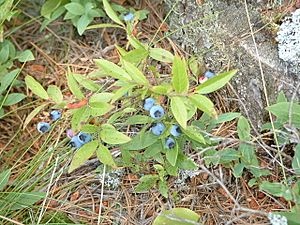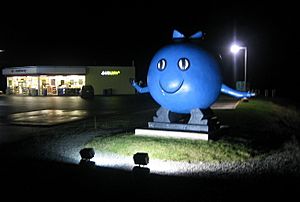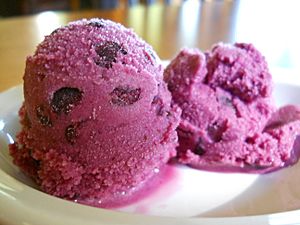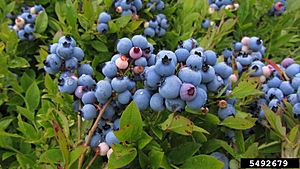Lowbush blueberry facts for kids
Quick facts for kids Lowbush blueberry |
|
|---|---|
 |
|
| Pancake Bay Provincial Park, Ontario | |
| Scientific classification | |
| Kingdom: | |
| (unranked): | |
| (unranked): | |
| (unranked): | |
| Order: | |
| Family: | |
| Genus: | |
| Species: |
V. angustifolium
|
| Binomial name | |
| Vaccinium angustifolium |
|
| Synonyms | |
|
|
The lowbush blueberry (scientific name: Vaccinium angustifolium) is a type of blueberry that grows naturally in eastern and central Canada. You can find it from Manitoba all the way to Newfoundland. It also grows in the northeastern United States, reaching as far south as the Great Smoky Mountains and west to the Great Lakes area.
Contents
What's in a Name?
The scientific name angustifolium comes from two old Latin words. Angustum means 'narrow', and folium means 'leaf'. So, angustifolium simply means 'narrow-leafed'. This name is also used for other plants with narrow leaves.
About the Lowbush Blueberry

The lowbush blueberry is a small, spreading shrub that loses its leaves in the fall. It usually grows about 5 to 60 centimeters (2 to 24 inches) tall. This plant has special underground stems called rhizomes. These rhizomes can stay hidden in the ground for up to 100 years! When they get enough sunlight, water, and air in the soil, they start to grow.
The leaves are shiny and blue-green in summer. In the fall, they turn beautiful shades of red. The leaves are wide and oval-shaped. The flowers are white and shaped like bells, about 4 to 6 millimeters (0.16 to 0.24 inches) long.
The fruit is a small, sweet, dark blue or black berry. These berries are packed with healthy things like antioxidants and flavonoids. Lowbush blueberries grow best in forests, old farms, or open areas with soil that drains well and is a bit acidic. Sometimes, they cover large areas, creating natural "blueberry barrens" where almost nothing else grows.
A healthy blueberry stem can have many buds. Each bud can open and produce several flowers. A blueberry field that is completely covered with plants can have as many as 150 million flowers per acre!
Fire and Blueberry Growth
Lowbush blueberry plants can survive fires. In fact, their numbers often grow after a forest fire. Because of this, blueberry farmers sometimes burn their fields every few years. This helps get rid of other plants and adds nutrients to the soil. In Acadian French, a blueberry field is called a brûlis, which means 'burnt place', because of this old method.
Where Lowbush Blueberries Grow
Lowbush blueberries are native to Canada, Maine, and Massachusetts. They are also grown there for sale, mostly harvested from wild areas that are managed by farmers. Many people enjoy picking these berries for fun.
Animals and Blueberries
Lots of animals also love lowbush blueberries! These include black bears, coyotes, raccoons, foxes, porcupines, white-tailed deer, and many types of birds.
To protect their crops from these hungry visitors, farmers often put up fences. Some even use special sound systems called "bird squawkers." These systems play sounds of predator birds during the day to scare away birds. At night, they can be set to discourage animals that eat crops in the dark.
Black bears can cause a lot of damage while eating blueberries. They roll around and can flatten the plants. They often eat berries from sunrise to sunset.
Caterpillars and Blueberry Leaves
The leaves of the lowbush blueberry are also a favorite food for many kinds of caterpillars. Some of these include the pale tiger moth, the peppered moth, the chain-dotted geometer, and many others.
How Blueberries are Pollinated
Honey Bees and Bumble Bees
During the harvest season, blueberry farmers often rent honey bee hives. They place these hives in their fields to help with pollination. Farmers usually put 1 to 8 hives per acre. The hives are brought into the fields when about 10-20% of the flowers are blooming. This makes sure the bees have enough food right there. The hives usually stay in the fields for about two weeks. This allows the bees to pollinate different types of blueberry plants, which bloom at slightly different times.
Some farmers also use bumble bees to help with pollination. Bumble bees can fly in colder and wetter weather than honey bees. They also pollinate in a different way. Bumble bees can "buzz-pollinate" flowers. This means they vibrate their bodies to shake pollen out from deep inside the flower.
Wild Bees
Blueberry farmers also depend on many wild bees for pollination. These include solitary bees like Andrena carlini and Colletes inaequalis.
Taking Care of Blueberry Plants
Long ago, Native Americans in parts of eastern Maine would regularly burn away trees and shrubs. This helped the blueberry plants grow better.
Today, farmers use different ways to help blueberry production. They might burn the land or use machines like mowers to cut the plants very close to the ground. These methods help the underground rhizomes spread, which means more blueberry plants will grow. Some farmers cut the plants in the fall after harvesting, leaving a small stem. Then, they burn the rest of the plants in the spring, which uses less fuel.
Blueberry Products
About 90% of wild lowbush blueberries are sold "IQF," which means "Individual Quick Frozen." This keeps them fresh for a long time. Some berries are sold fresh during harvest season at markets and grocery stores. You can also find 100% pure wild blueberry juice.
Blueberries can be used to make many yummy foods! Think of blueberry smoothies, blueberry sauce for waffles, blueberry grunt, blueberry lemon loaf, blueberry crisp, blueberry muffins, and blueberry jam. They can also be a tasty topping for cereal or yogurt.
Wild blueberries from Nova Scotia are sent to many countries, including the United States, Japan, Germany, and the United Kingdom.
Blueberry Nutrition
Wild blueberries are a good source of Vitamin C and fiber, which helps your body digest food. They have no fat, sodium, or cholesterol. A cup of berries has only about 80 calories.
Recent studies show that the natural colors in the berries' skin, called anthocyanins, are very good for your health. These anthocyanins contain antioxidants. Antioxidants help fight against harmful things in your body called free radicals. Free radicals can cause problems like cancer, heart disease, other illnesses, and even make you age faster. In one study, wild blueberries had more antioxidants than 40 other fruits and vegetables!
Blueberries also contain things called tannins, which are also found in cranberries. Tannins can help stop bacteria that cause urinary tract infections from sticking to your bladder. This allows the bacteria to pass out of your body without causing problems.
Special Berries

The lowbush blueberry is the official state fruit of Maine. The wild lowbush blueberry is also the official berry of Nova Scotia, a province in Canada. The town of Oxford, Nova Scotia is even known as the "Wild Blueberry Capital of Canada"!
See also
 In Spanish: Vaccinium stenophyllum para niños
In Spanish: Vaccinium stenophyllum para niños



